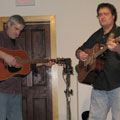Death Masks
By Lon D. Campbell, 2008
In 1966 I attended the American Academy McAllister Institute of Funeral Service, Inc. As part of that curriculum we were allowed to construct so called “Death Masks.” This was accomplished by creating a mask of a living individual in the classroom using Plaster of Paris. The “volunteer” was placed on a cot, raised to waist high level, and made to lie comfortably while a classmate applied the plaster to said classmate’s face, creating a mask once the appliqué had dried.
Obviously, there was more to this procedure than initially disclosed. For one thing, one must be concerned that without proper procedure the plaster would harden on dry skin and be difficult to dislodge without proper skill and training. So, let’s start with a list of things that must be done to insure that this event can be carried out in a fun-filled couple of hours or less.
First of all, any exposed skin must, and I emphasize must, be covered with petroleum jelly. This ensures that the plaster will not adhere to the skin. Secondly, a primary airway must be initially established for obvious reasons. This is accomplished by maintaining an opening most commonly through the nose. This is preferred to the mouth since to create a proper death mask the mouth should remain closed. Thirdly, the individual must be made to feel comfortable at all times, which for some can be a very difficult task since the overall exercise can be quite stressful and tedious. Additionally, some rules or procedures must be established to ensure that the “subject” will be made to feel safe and comfortable, namely that one can ask for and be granted a stop or a cease and desist order at any time, stopping the entire exercise at once.
One of the more unique and amazing aspects of this entire exercise is that the mask itself is an exact replica of the individual or model being replicated. One can’t get any closer to exact form and, as we know, form always follows function. The mask itself must be removed from the head or face of the individual in one piece and smeared with the same petroleum jelly to ensure a proper mold. Without this mold the entire procedure is lost. The mold when properly utilized will give out the exact configuration of the face. Once the mold has been smeared with the jelly and filled with a coat of Plaster of Paris, the mold is set aside to dry. Once dried, the mold itself can be cracked or destroyed to reveal a true death mask.
It should be noted that a death mask can be utilized on either a cadaver or a live subject. During the Victorian Era, the craze was most prevalent whereby a family would create a death mask most commonly through the undertaker to be displayed on a wall in the home to show the true-life features of the deceased. This practice was short lived and “died out” shortly after or during the Victorian Period.






